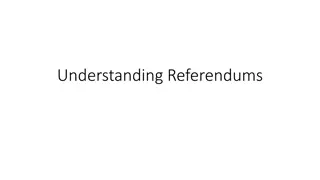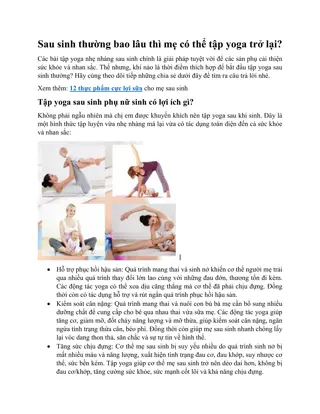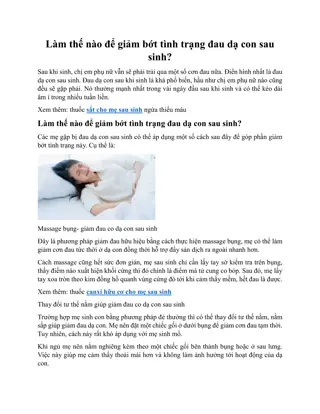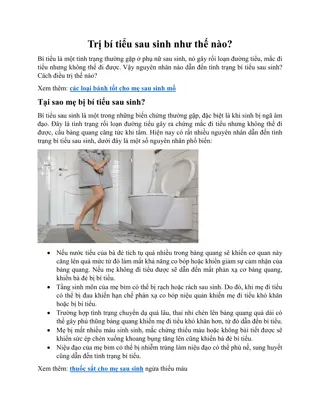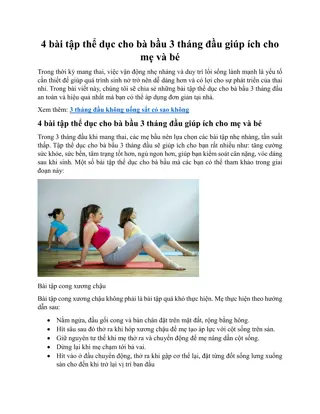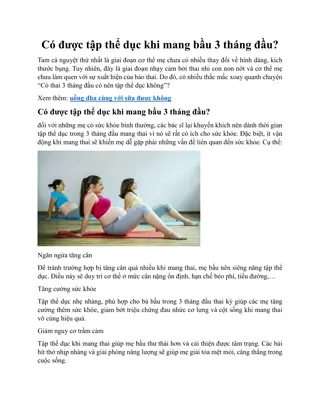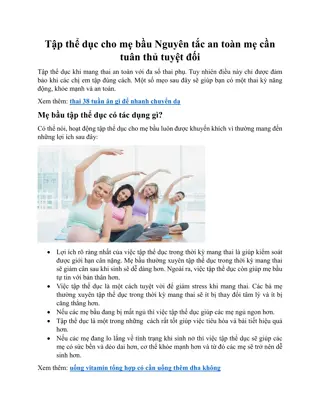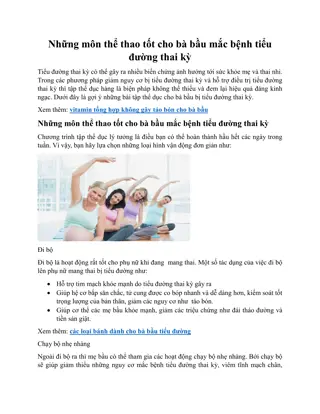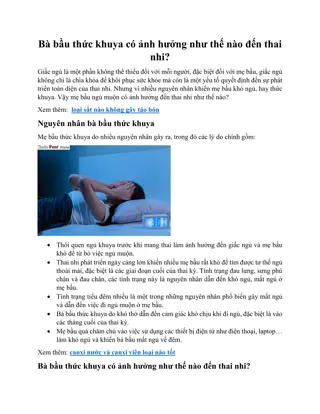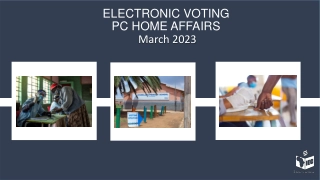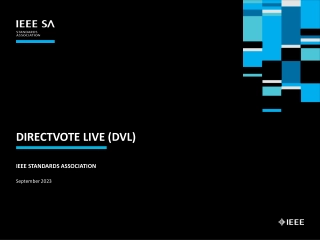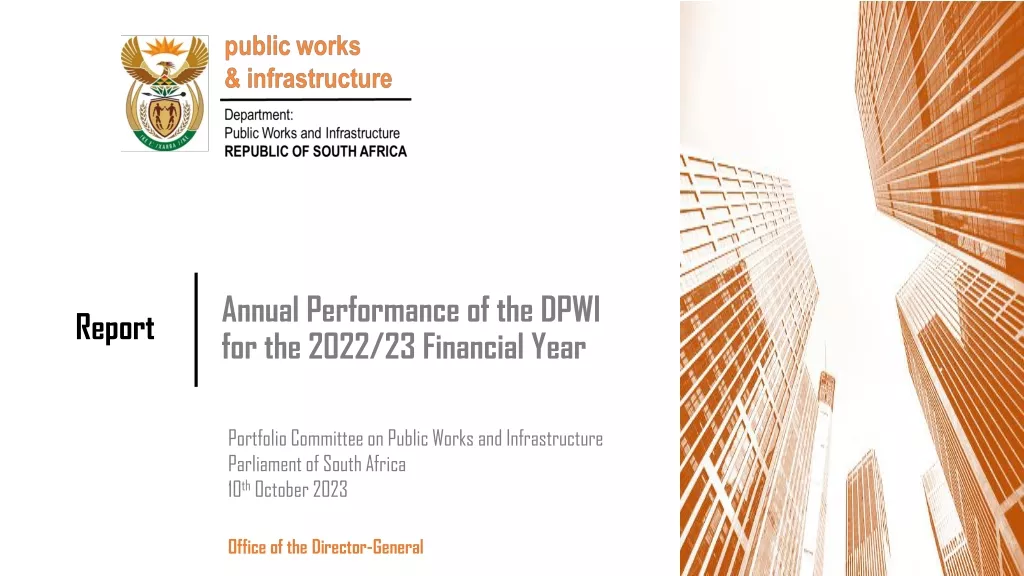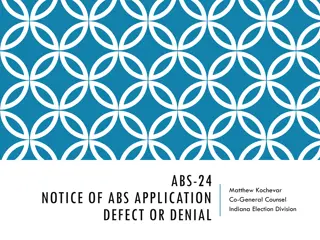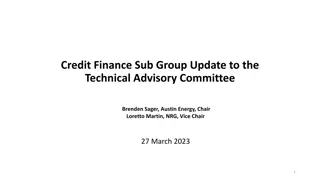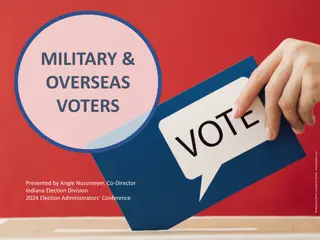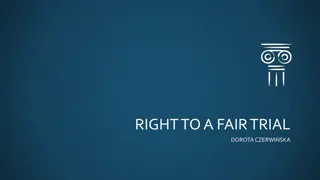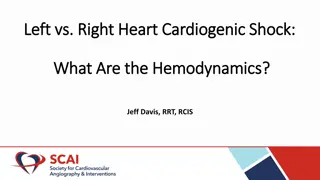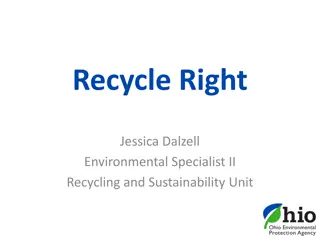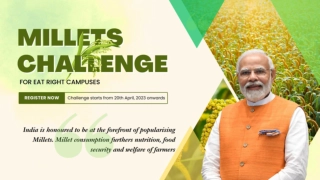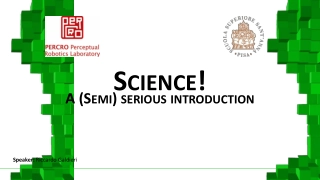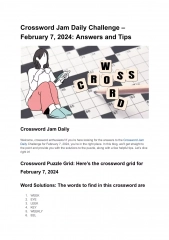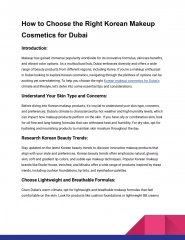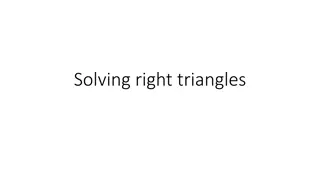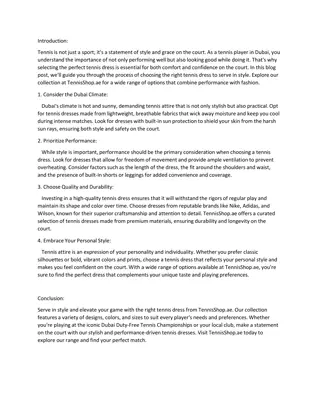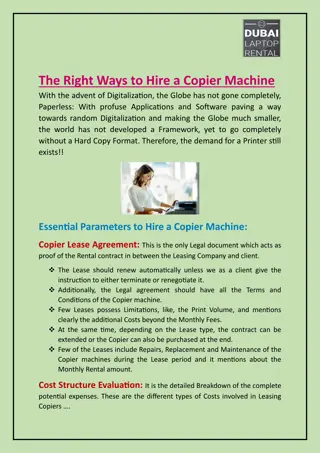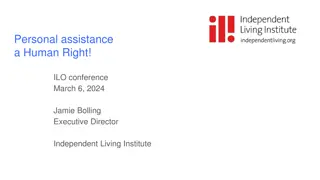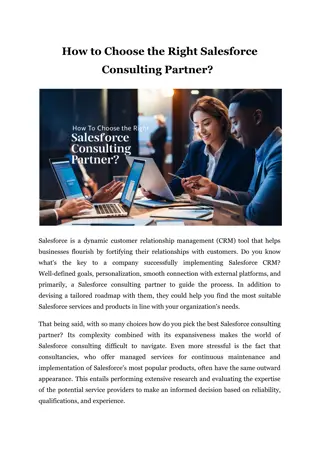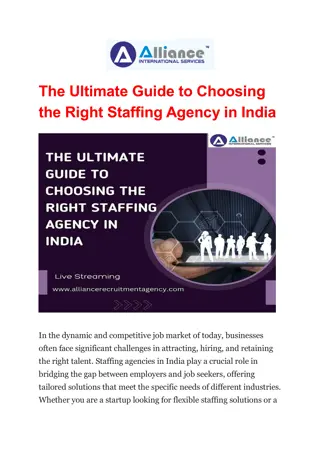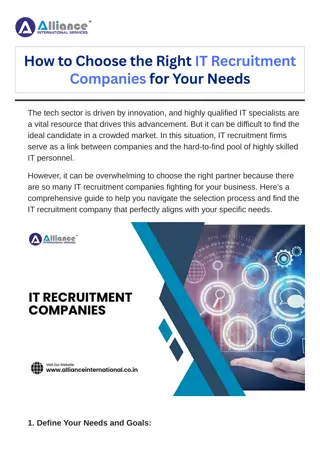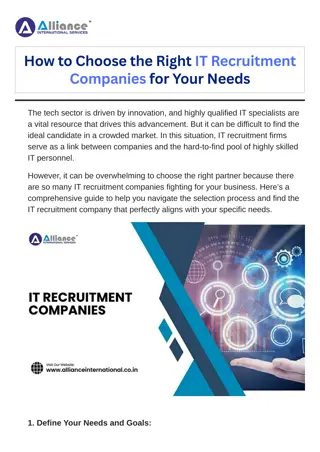The Right to Vote
Join Tom Patterson in this McGraw-Hill webinar on September 15, 2023, as he discusses the conflicting constitutional provisions for the right to vote and the impact on Supreme Court decisions. Explore the politics of ballot access and the historical context of voter suppression. Learn about key points related to voting as a constitutional right and the rare instances of political parties advocating for changes in voting laws.
- right to vote
- Constitution
- conflicting provisions
- Supreme Court
- ballot access
- political parties
- voter suppression
The Right to Vote
PowerPoint presentation about 'The Right to Vote'. This presentation describes the topic on Join Tom Patterson in this McGraw-Hill webinar on September 15, 2023, as he discusses the conflicting constitutional provisions for the right to vote and the impact on Supreme Court decisions. Explore the politics of ballot access and the historical context of voter suppression. Learn about key points related to voting as a constitutional right and the rare instances of political parties advocating for changes in voting laws.. Download this presentation absolutely free.
Presentation Transcript
THE RIGHT TO VOTE: WHY IT S NOT FULLY PROTECTED BY THE CONSTITUTION MCGRAW-HILL WEBINAR SEPTEMBER 15, 2023 Tom Patterson
WE THE PEOPLE, 14e NUMBER ONE in American Government For a free instructor s review copy of We the People, please contact Michael Gedatus (poly@mheducation .com) Accessibility through Readability Critical Thinking Emphasis Case Studies & Pedagogy Even-handed approach with broad appeal Unparalleled Instructor Support 24 Complimentary HarvardX/EdX Video Lectures
THE RIGHT TO VOTE: U.S. CONSTITUTION, LAW, AND PARTISAN POLITICS MCGRAW-HILL WEBINAR SEPTEMBER 14, 2021 Tom Patterson
Key Points for Today Voting as a constitutional right constitutional provisions for the right to vote are conflicting, which has given the Supreme Court leeway in deciding voting rights cases. Politics of ballot access Rarely has a political party advocated major change in voting laws unless it was thought to improve its chances of winning elections.
The Vote, as Originally Specified Article 1, Section 2: the Electors [voters] in each State shall have the Qualifications requisite for Electors [voters] of the most numerous Branch of the State Legislature. Compare that provision with the right to speak freely: First Amendment: Congress shall make no law . . . abridging the freedom of speech . . .
Subsequent Amendments 15thAmendment (1870): The right of citizens of the United States to vote shall not be denied or abridged by the United States or by any State on account of race, color, or previous condition of servitude. 19thAmendment (1920): The right of citizens of the United States to vote shall not be denied or abridged by the United States or by any State on account of sex. 26thAmendment (1971): The right of citizens of the United States, who are eighteen years of age or older, to vote shall not be denied or abridged by the United States or by any State ... Note: None of these amendments nullified state authority over voter eligibility provided in Article 1, Section 2.
Post-Reconstruction Voter Suppression Although the 15thAmendment was to prevent abridgment of the vote on account of race and color, white-controlled southern legislatures enacted laws intended to keep Black men from voting. Literacy test a test typically administered only to Blacks and poor Whites. Poll tax an annual tax that had to be paid for a citizen to be eligible to vote aimed at keeping poor Blacks and Whites from voting. Grandfather Clause excused citizen whose grandfather was eligible to vote meeting the other requirements for registering to voter aimed at disenfranchising descendants of enslaved people. 7
The devices were designed to disqualify lrge numbers of Black citizens An example question from Louisiana s literacy test: Draw a figure that is square in shape. Divide it in half by drawing a straight line from its northeast corner to its southwest corner, and then divide it once more by drawing a broken line from the middle of its western side to the middle of its eastern side. 8
A test case of the constitutionality of these laws arose out of Mississippi Constitution Convention of 1890 The Convention was called to draft a wholly new constitution for the state of Mississippi. The presiding officer, a white man by the name of Solomon Calhoon, opened the proceedings by declaring, We came here to exclude the Negro." And that s what they did. The new constitution specified the poll tax, literacy test, and grandfather clause as conditions affecting voting eligibility. Prima facie, those provisions were a clear-cut violation of the 15thAmendment. 9
Williams v Mississippi (1898) In Williams v. Mississippi, the Supreme Court in a 9-0 ruling upheld the provisions, holding that because the provisions theoretically applied to every citizen and did not explicitly refer to Black citizens, the provisions were a valid exercise of the state s authority over voting qualifications granted in Article 1, Section 2. In case after case, the Court continued to uphold the legality of these devices save for the Grandfather Clause, which was struck down in 1915.
Mississippi was the extreme case of voter suppression percentage of Mississippi adults registered to vote in 1964 Whites 65% Blacks 5% Source: Whites percentage was estimated from multiple sources; black percentage from US Comission on Civil Rights..
1960s Congress Intervenes Tired of waiting for the Court to reverse course, Congress in 1962 passed the 24th Amendment outlawing the poll tax for federal elections. It was ratified in 1964. Then in 1965, Congress passed the Voting Rights Act, which outlawed the literacy test and authorized federal registrars to go into the South and add Black citizens to the voter rolls. The Voting Rights Act had two key provisions: Section 4. Contained the formula that defined which jurisdictions were subject to provisions of the Act. A jurisdiction was subject to the Act if It had used a test or device (such as the literacy test) as a condition for voter eligibility and its overall voting rate was less than 50 percent. Section 5. (Preclearance requirement) Required covered jurisdictions receive US Justice Department approval to make changes to their election laws. The constitutional authority for the Voting Rights Act was Section 2 of the 15th Amendment which reads, Congress shall have the power to enforce this article by appropriate legislation.
Jurisdictions Subject to Preclearance under the Voting Rights Act Note: Texas, Alaska, & Arizona were added to list in 1975
Congressional Vote on 1965 Voting Rights Act Region rather than party was the driving factor SENATE HOUSE Percentage voting in favor Percentage voting in favor 100 96 21 5 South Non-South South Non-South NOTE: South is defined as AL, AR, FL, GA, LA, MS, NC, SC, TX & VA
Effect of 1965 Voting Rights Act on Black Registration percentage of adult African Americans registered to vote 60 58 52 52 53 57 37 September 1967, two years after passage of VRA 38 31 27 18 5 March 1965, before passage of VRA MS AL GA LA SC VA Source: US Commission for Civil Rights, Minority Representation and the Quest for Voting Equality.
In this same decade. . . The Supreme Court changed its position on the right to vote, explicitly declaring it a fundamental constitutional right: No right is more precious in a free country than that of having a voice in the election of those who make the laws under which, as good citizens, we must live. Other rights, even the most basic, are illusory if the right to vote is undermined. Our Constitution leaves no room for classification of people in a way that unnecessarily abridges this right. Justice Hugo Black, Wesberry v. Sanders (1964)
The Supreme Court also rebuked the constitutional reasoning of earlier Courts Though the States have power to fix voting qualifications, they cannot do so contrary to the Fourteenth Amendment or any other constitutional provision. Katzenbach v. Morgan (1966)
1993 Motor Voter Act Required state motor vehicle and social welfare offices to provide clients with the opportunity to register to vote. It was opt-in, the individual had to consent to register. The Motor Voter Act marked the reemergence of partisanship as a driving factor in ballot access.
Democrats Motive in Enacting Motor Voter percentages are those of the 1992 presidential election 80 64 61 51 47 43 lower third of income middle third of income upper third of income Registration rate Democratic % of two-party vote
Constitutionality of Motor Voter Act Republican-controlled states filed suit, claiming the law violated the 10thAmendment and imposed an unfunded mandate (their offices would bear the cost of implementation). Six federal district courts and two federal circuit courts rejected the lawsuits, citing Article 1, Section 4 of the Constitution, which grants Congress the power to determine the times, places, and manner of electing federal officials. The Supreme Court declined to hear on appeal the circuit court rulings.
Government-Issued IDs as a Registration Requirement 2003 Republican-controlled Georgia and Indiana state legislatures enacted laws requiring citizens to have a government-issued voter ID in order to register to vote STATES WITH PHOTO ID REQUIREMENT Blue-colored states have photo ID requirement Over the next decade, two dozen states enacted similar laws all but one (Rhode Island) by Republican-controlled legislatures
Republicans Motive in Requiring Govt-Issued ID percentage without government issued photo ID Race/ethnicity White 5 Hispanic 10 Democratic- leaning voter group Black 13 Annual Income more than 150K 2 less than 25K 12 Age 30 or older 7 18-29 12 Source: American National Election Studies survey, 2012.
Constitutionality of Voter ID Laws Crawford v Marion County (2008) Supreme Court in 6-3 decision upheld Indiana s strict voter ID law, concluding it was valid exercise of states power over elections granted them by Article 1, Section 2 of the US Constitution. The Court s majority acknowledged that partisan motivation played a part in law s enactment: [The law] should not be disregarded simply because partisan interests may have provided one motivation for the votes of individual legislators. Crawford v. Marion County Election Board (2008)
Constitutional Basis for Crawford Ruling The Indiana law had been challenged on grounds it violated the 14thAmendment s equal protection clause by placing an unequal burden on some voters namely, those without a government-issued photo ID, who are disproportionately people of color. The Court s majority rejected that claim, instead privileging state authority under Article 1, Section 2 over the 14thAmendment by concluding that the law did not place an undue burden on those without such an ID. The undue burden standard had been established 4 decades earlier in Harper v. Virginia Board of Elections (1966), which struck down the use of the poll tax in state elections as an undue burden on low-income citizens (the 24thAmendment had outlawed in federal elections). The poll tax in 1965 was about $10 annually, which was the equivalent of $65 by 2008. After the Crawford ruling, a Harvard University Law School study calculated the cost in time and money to obtain a state-issued photo ID. The study estimated it at about $175 for the average person, roughly 3 times that of the poll tax.
Partisanship on the Court? Of the historically important Supreme Court on ballot access,* Crawford was the first ruling where the majority was made up entirely of justices appointed by presidents of the same party. All 6 justices in the majority were Republican appointees. The Democratic-appointed justices dissented. Two years later, Citizens United, which addressed the issue of campaign finance, was similarly decided. All 5 justices in the majority were Republican appointees. *The cases are those listed in Democracy Docket s Ten Voting Rights Cases That Shaped History. Nine of the cases addressed ballot access. Most of the cases preceding Crawford were decided by a 9- 0 or 8-1 vote.
Voting Rights Act Shelby County v. Holder (2013) The case arose when Republican officials in Shelby County, Alabama filed suit, claiming that federal oversight of their election proceedings violated their authority under Article 1, Section 2. The Supreme Court sided with Shelby County, invalidating as unconstitutional Section 4 of Voting Rights Act, saying its formula for determining which jurisdictions were subject to oversight was outdated. The decision made Section 5 (preclearance provision) inapplicable because it was now impossible identify the jurisdictions subject to preclearance (requiring Justice Department approval prior to making any change affecting ballot access). Shelby County was decided by a 5-4 vote, with all 5 justices in the majority being Republican appointees.
Impact of the Shelby ruling Within a year of Shelby, every state previously subject to the preclearance requirement (all of which had Republican-controlled legislatures) had changed its voter eligibility rules. The new Texas law, for example, required voters to show an acceptable form of photo ID to be eligible to vote. One of the acceptable forms of photo ID was a concealed handgun license. Not acceptable, for example, was a state government employee photo ID. An earlier version of that law had been voided by the Justice Department under the then-existing preclearance requirement. In 2014, Supreme court upheld the Texas law with the Republican- appointed justices constituting the majority. Source: Supreme Court Allows Texas to Use Controversial Voter ID Law, Washington Post, October 18, 2014.
Voting Rights Act Brnovich v Democratic National Committee (2021) The Arizona Republican-controlled legislature enacted a law making it a felony for citizens (with the exception of family members, licensed caregivers, and election officials) to collect ballots for delivery to polling places ( ballot harvesting ) or to vote at a precinct other than the one assigned. These practice were prevalent among Arizona s Native Americans. The law was challenged as a violation of Section 2 of the Voting Rights Act, which prohibits election procedures that discriminate against historically disadvantaged groups.
Brnovich v Democratic National Committee (2021) Supreme Court upheld Arizona s law, concluding that the law did not have a racially discriminatory purpose and was a lawful exercise of state authority over elections. The case was decided by a 6-3 vote, with all 6 justices in the majority being Republican appointees. They wrote: The mere fact there is some disparity in impact does not necessarily mean that a system is not equally open or that does not give everyone an equal opportunity to vote. it
Allen v. Milligan (2023) Alabama s redistricting map after the 2020 census was challenged as a violation of Section 2 of the Voting Rights Act on grounds it was drawn in a way that discriminated against Black voters by packing them into a single district, diluting their vote elsewhere in the state. In a ruling that surprised analysts, the Supreme Court ruled that the map was racially discriminatory, ordering Alabama to redraw the map in a non-discriminatory way, Republican appointees John Roberts and Brett Kavanaugh joined the 3 Democratic appointees to form the majority. The Court s majority held that Section 2 of the VRA is constitutional in the context of redistricting.
The Larger Issue of Partisan Gerrymandering The significance of the Allen ruling is that, for the first time, the Court held that racial gerrymandering is included in Section 2 of the VRA. Previous rulings had outlawed it in the context of the 14th Amendment s equal protection clause. Racial gerrymandering is an exception to the Court s position on partisan gerrymandering. In Rucho v. Common Cause (2019), the Court held that partisan redistricting is not subject to review in federal courts. The Court held, that although extreme partisan gerrymandering is incompatible with democratic principles, there is no objective standard that judges can apply in making that judgment or remedying the problem. The case was decided in a 6-3 vote, with all 6 justices in the majority being Republican appointees. In dissent, Democratic appointee Elena Kagan wrote: The practices challenged in these cases imperil our system of government. Part of the Court s role in that system is to defend its foundations. None is more important than free and fair elections.
Impact of Partisan Gerrymandering In 2018, the Center for American Progress examined the impact of partisan gerrymandering after the 2010 census. It concluded that 59 seats were shifted per election - 20 in favor of Democrats and 39 in favor of Republicans. The impact is greater at the state level because there are countless more ways to carve a state into several hundred state legislative districts than into a small number of congressional districts. Example: In Wisconsin s 2018 election, Republicans won 64 percent of the seats in the State Assembly despite winning only 47 percent of the statewide vote. (Washington Post study, December 2018) Why it matters? In most states, the state legislature controls congressional redistricting and has the power over voting laws.
The Continuing Battle over Ballot Access What Republicans Are Doing In the 2020 presidential election, voters who cast mail-in, absentee, and early votes went strongly for Biden. Those who voted on Election Day strongly supported Trump. Since that election, nearly 2 dozen Republican-controlled legislatures have enacted laws putting limits on mail-in, absentee, or early voting. Some of these laws are currently under challenge in state and federal courts.
The Continuing Battle over Ballot Access What Democrats Are Doing Since 2016, 18 states*, all but a couple controlled by the Democrats, have instituted Automatic Voter Registration (AVR) in the context of the Motor Voter Act originally, registration was opt in when at a state motor vehicle or social welfare office, individuals had to agree to be added to the voter registration rolls AVR is an opt-out system individuals are automatically registered unless they decline being added to the rolls Oregon was the first state to adopt AVR and its registration rate under Motor Voter Act tripled Vermont was second, and its rate doubled The 18 states are AK, CA, CO, CT, IL, ME, MD, MA, NJ, NM, NY, NV, OR, RI, VT, VA, WA, WV.
Relationship between Barriers to Voting and Voter Turnout Rate (2020 presidential election) 50 MN CO highest ME WI WA 45 OR NH NJ VT MI 40 IA MT VA MA FL 35 CT NC PA MD DE State turnout rate 30 NE UT AL CA GA 25 ID OH IL MO SD 20 AZ KS RI NV KY 15 LA WY SC ND NY 10 AK IN NM TX MS 5 TN WV HI AR OK 0 lowest 0 5 10 15 20 25 30 35 40 45 50 lowest highest State rank in voting barriers Source: For barriers: Scot Schranfruagal, et al, Cost of Voting in the American States:2020, Election Law Journal (cost index is based registration deadlines and restrictions; For turnout, US Census Bureau (based on percentage of vote-eligible citizens who voted).
A Quick Note - Ballot Access at the Top Ballot access can be an issue for candidates as well as voters.. Under state law, Republican and Democratic nominees are automatically granted a place on the ballot. For a third-party or independent candidate, ballot access can be a major hurdle for example, Oklahoma requires, a new party to submit a petition signed by 5% of the turnout level in the previous election. The No Labels Party has so far been able to achieve qualification for the 2024 election in only 10 states. Conceivably, Donald Trump could find himself off the ballot in 2024. Lawsuits have been filed in Colorado and Minnesota to ban him from the ballot through Section 3 of the 14th Amendment, which bars from office anyone who while holding office took an oath to protect the Constitution and then engaged in insurrection or rebellion.
Thank You Questions, Comments, Corrections, Criticisms?
WE THE PEOPLE, 14e NUMBER ONE in American Government For a free instructor s review copy of We the People, please enter your name in the chat box. Accessibility through Readability Critical Thinking Emphasis Case Studies & Pedagogy Even-handed approach with broad appeal Unparalleled Instructor Support 24 Complimentary HarvardX/EdX Video Lectures


